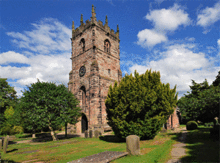St Peter's Church, Prestbury
| St Peter's Church Prestbury | |
|---|---|

St Peter's Church from the southwest in 2007
|
|
| Coordinates: 53°17′21″N 2°09′01″W / 53.2893°N 2.15025°W | |
| Location | Prestbury, Cheshire |
| Country | England |
| Denomination | Church of England |
| Churchmanship | Mixed |
| Website | St Peter's, Prestbury |
| History | |
| Dedication | St Peter |
| Architecture | |
| Status | Parish church |
| Functional status | Active |
| Heritage designation | Grade I |
| Designated | 14 April 1967 |
| Architectural type | Church |
| Style | Gothic |
| Specifications | |
| Materials | Ashlar buff and pink sandstone, Kerridge stone-slate roof |
| Administration | |
| Deanery | Macclesfield |
| Archdeaconry | Macclesfield |
| Diocese | Chester |
| Province | York |
| Clergy | |
| Vicar(s) | Rev Patrick Angier |
| Assistant priest(s) | Rev Pamela Hardman |
| Laity | |
| Reader(s) | David Briggs, David Jenkins, Margaret Tate, Keith Ravenscroft, Avril Ravenscroft |
| Organist(s) | Andrew Burr |
| Churchwarden(s) | Richard Raymond, Geraldine Yandell, Anne Stirling, Trevor Stephens |
St Peter's Church is the parish church of Prestbury, Cheshire, England. It is probably the fourth church on the site. The third, the Norman Chapel, stands in the churchyard. The church is recorded in the National Heritage List for England as a designated Grade I listed building. The Norman Chapel, the lychgate and west wall, the Hearse House, and the sundial in the churchyard are listed at Grade II. It is a Church of England parish church in the diocese of Chester, the archdeaconry of Macclesfield and the deanery of Macclesfield.
There is compelling evidence that there was a church at Prestbury ("priest’s enclosure") in the Anglo-Saxon era. After the Norman conquest of England, the church, probably the second on the site, came into the possession of the powerful baron Hugh Kyvelioc who gave it to the Abbey of St Werburgh in 1170-1173.
The monks demolished the Anglo-Saxon church and built what is now called the Norman Chapel. The chapel served as a place of worship for the vast Parish of Prestbury until after the Magna Carta and the deaths of King John and Pope Innocent III in 1216.
In 1220, the monks, supported by the Davenports of Marton (and later Henbury), the Piggots of Butley and the family de Corona (predecessors of the Leghs of Adlington) started to build what became the chancel and nave of the present church. Rather than incorporate the chapel into the new building, as was often done, they left it in the churchyard. Some time later, it was given to the Davenports for use as a place of burial and perhaps as a private chapel.
...
Wikipedia
